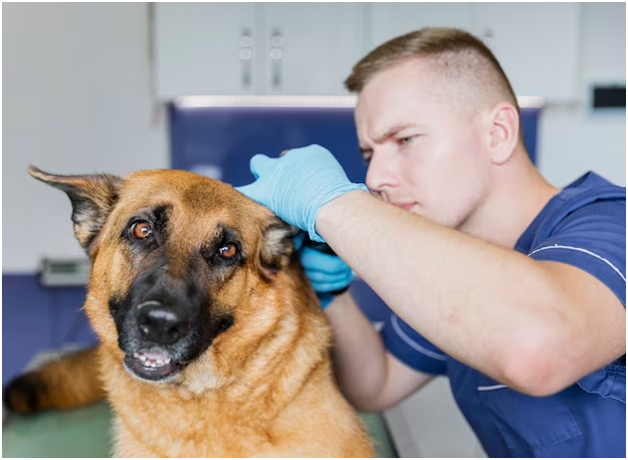Cushing’s Disease is a condition that affects dogs and, less commonly, cats. It is characterized by an excess of cortisol, a hormone produced by the adrenal glands. Cushing’s Disease can manifest in various ways, including increased thirst and urination, hair loss, a pot-bellied appearance, and more. Without appropriate treatment, it can lead to severe health problems, such as liver failure or even death. The good news is that there are treatments available to manage this condition in dogs and cats. In this article, we will explore the causes of Cushing’s Disease in dogs, its signs and symptoms, and how to recognize it in your canine companion.
Causes of Cushing’s Disease in Dogs
Cushing’s disease in dogs results from an overproduction of cortisol, a hormone with critical roles in the body’s stress response. While the exact cause of cushings disease dogs are not always clear, there are several potential factors that can contribute to this condition.
The most common cause of Cushing’s disease in dogs is the presence of a tumor on the pituitary gland or adrenal glands. These tumors lead to excessive secretion of cortisol, causing an overactive immune response. Symptoms can vary based on the size and location of the tumor but often include increased thirst and urination, weight gain, hair loss, and excessive panting. The treatment typically involves surgical removal of the tumor, medication, or radiation therapy when possible.
Another potential cause of Cushing’s disease in dogs is an imbalance between two hormones: corticotropin-releasing hormone (CRH) and adrenocorticotropic hormone (ACTH). An imbalance in these hormones can result in excessive cortisol production. Treatment usually involves addressing the underlying hormonal imbalance with medication.
Symptoms of Cushing’s Disease in Dogs
Cushing’s disease in dogs can manifest a wide range of symptoms, which may vary in severity. It is essential for dog owners to recognize these signs to seek timely veterinary care. Here are some common symptoms:
- Excessive Thirst and Urination: Dogs with Cushing’s disease often drink more water than usual and urinate more frequently.
- Increased Hunger: Despite an increased appetite, dogs may not show significant weight gain due to the characteristic redistribution of fat in certain areas.
- Hair Loss: Thinning hair, especially on the belly and other areas with minimal fur coverage, is a common sign.
- Skin Infections: Excessive scratching and skin irritation can lead to recurrent skin infections.
- Muscle Weakness: Dogs may experience muscle wasting and weakness due to cortisol’s effects on protein metabolism.
- Panting: Excessive panting, even when not hot or active, is another common symptom.
- Pot-Bellied Appearance: The accumulation of fat in the abdominal area can give dogs a pot-bellied appearance.
- Lethargy and Muscle Wasting: Dogs with Cushing’s disease may become lethargic and experience muscle wasting.
Diagnosis and Treatment of Cushing’s Disease in Dogs
Diagnosing Cushing’s disease in dogs involves a combination of physical examinations, laboratory tests, and imaging studies. To confirm the diagnosis, veterinarians typically evaluate cortisol levels through blood tests and perform imaging studies like CT scans or ultrasounds to detect any tumors on the adrenal glands or pituitary gland.
Once a diagnosis is confirmed, treatment options can be considered. The choice of treatment depends on the underlying cause. In cases of a tumor, surgical removal or other targeted treatments may be necessary. For dogs with non-tumor-related Cushing’s disease, medication can help manage symptoms and improve the quality of life.
It’s crucial for dog owners to work closely with their veterinarians to develop a tailored treatment plan that considers the dog’s individual needs and overall health.
Prevention of Cushing’s Disease in Dogs
Preventing Cushing’s disease in dogs involves maintaining their overall health and well-being. While there is no guaranteed method to prevent the disease, there are some steps you can take:
- Regular Veterinary Checkups: Schedule regular checkups with your veterinarian. They can monitor your dog’s health and detect any issues early.
- Moderate Corticosteroid Use: Avoid excessive or prolonged use of corticosteroid medications, as they can contribute to Cushing’s disease.
- Weight Management: Help your dog maintain a healthy weight to reduce the risk of obesity-related health problems.
- Diet and Exercise: Provide a balanced diet and regular exercise to support overall health and reduce the risk of associated conditions.
- Promote a Low-Stress Environment: Minimize stressors and provide a calm and supportive environment for your dog.
While you cannot completely prevent Cushing’s disease, these steps can help reduce the risk and improve your dog’s overall health and well-being.
In conclusion, Cushing’s Disease is a significant medical condition that affects dogs, and early recognition and treatment are crucial to maintaining your pet’s quality of life. While there is no cure for Cushing’s Disease, timely diagnosis and proper treatment can help manage the condition and prevent further complications. Regular veterinary care and awareness of the disease’s symptoms are essential to ensure your dog receives the necessary care and support for a happy and healthy life.
